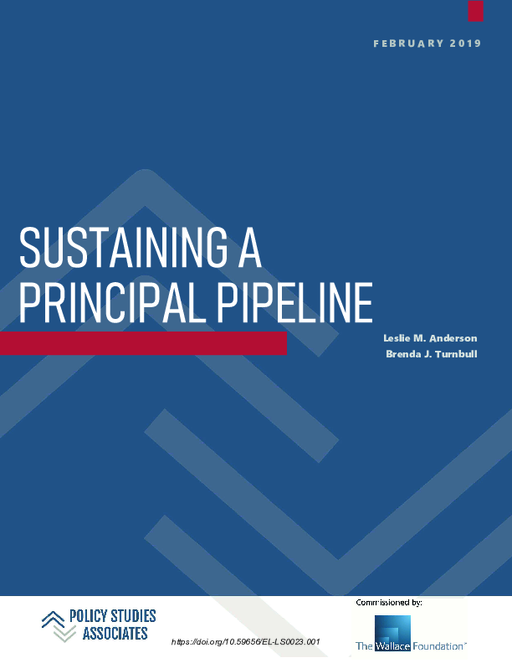Breadcrumb
- Wallace
- Reports
- Sustaining A Principal Pipeline
Sustaining a Principal Pipeline

- Author(s)
- Leslie M Anderson and Brenda J. Turnbull
- Publisher(s)
- Policy Studies Associates, Inc.
Summary
How we did this
This study looks at the six school districts that took part in the Principal Pipeline Initiative two years after foundation funding for the effort ended. Key sources included a survey of principals and interviews with district leadership development decision makers, principal supervisors, university officials, and others. The research assesses continuity and change in district policies and practices and in principal perceptions as of 2018. It asks:
- To what extent and in what ways are districts still carrying out four key components of the Principal Pipeline Initiative?
- What changes have they made to their pipelines, and why?
- What do principals say about their preparation, hiring and placement, evaluation, and support? How is it similar to or different from key findings that the researchers reported earlier?
In 2011, six large school districts launched an effort, supported by The Wallace Foundation, to build better systems for preparing and supporting principals. The Principal Pipeline Initiative (2011-2016) positively affected student learning while reducing principal turnover. This study examines the pipelines in 2018, two years after foundation funding for the effort ended. It finds that the pipelines remained intact and valued. It also finds some changes in pipeline activities and organization.
Pipeline Components
Districts each had different approaches to building pipelines. But all six pipelines continued to have key components, including:
- Job standards that clearly spell out what principals need to know and do
- Strong pre-service training for future principals based on those standards
- Careful procedures to hire highly-qualified professionals and match them to the right schools
- Aligned on-the-job evaluation and support for novice principals.
Major Findings
The district efforts to improve preservice preparation made a difference. Principals who began preservice preparation after March 2012 reported stronger programs than those who had begun earlier. Specifically, later cohorts reported more emphasis on instructional leadership and school improvement. They also reported that preparation was more tailored to district context.
Novice principals continued to give positive answers to survey questions about their district job performance evaluations. Most perceived the evaluation systems as accurate, fair, based on clear expectations, and useful to them. They reported strong support from principal supervisors, coaches, and mentors.
Most principals in their first or second year (63 percent) reported an “excellent” fit between their skills and their school’s needs. Another 35 percent said the fit was “good.” Only 2 percent said the fit was “fair,” and zero percent said that it was “poor.” These results were positive but down slightly compared with a 2013 survey. The difference was not statistically significant.

District leaders are impressed with the skills of the principals they are hiring.
Changes Since 2016
The districts were altering some aspects of the pipelines as they learned more and their circumstances evolved.
- Standards for what a principal needs to know and be able to do were updated based on experience. Incorporating standards in other pipeline components (such as principal hiring and evaluation ) often revealed gaps and a need for revision.
- Districts were increasing leadership opportunities in schools. This included new responsibilities for assistant principals and other leaders, such as deans. One result was a larger pool of principal candidates to draw from. Districts also believed more leaders contribute to better teaching and learning.
- Districts were working to better coordinate the work of all those who advise or guide principals. These included principal supervisors, coaches, mentors, and central office departments. Coordination was important to ensuring that principals were not overwhelmed or given contradictory advice.
- Districts were continuing to increase the time principal supervisors had to focus on improving instructional leadership.
Overall the study found that district leaders were pleased with the results of the Principal Pipeline Initiative. Structures of the pipeline remained notably stable. District leaders no longer reported struggling to find highly qualified candidates.
District leaders surveyed believed that other districts could create or strengthen principal pipelines without substantial funding. To do so, three conditions are advisable:
- The superintendent should support the work.
- The work should be grounded in leadership standards.
- The district should work step-by-step to develop leaders who match district needs.
Key Takeaways
- Six large school districts launched the Principal Pipeline Initiative (2011-2016) to build better systems for preparing and supporting principals. Two years after the initiative ended, the pipelines remained intact and valued.
- Principals who began preservice preparation after March 2012 reported stronger programs than those who began earlier. Specifically, later cohorts reported more emphasis on instructional leadership and school improvement. They also reported that preparation was more tailored to the district context.
- Novice principals continued to perceive on-the-job evaluation as accurate, fair, based on clear expectations, and useful. They reported strong support from principal supervisors, coaches, and mentors.
- The districts were altering some aspects of the pipelines as they learned more and their circumstances evolved. These included revisions to leader standards, more leadership opportunities in schools, and improvements to on-the-job support.
- District leaders reported that they no longer struggled to find highly-qualified principal candidates. They believed other districts could create or strengthen principal pipelines without substantial funding.









